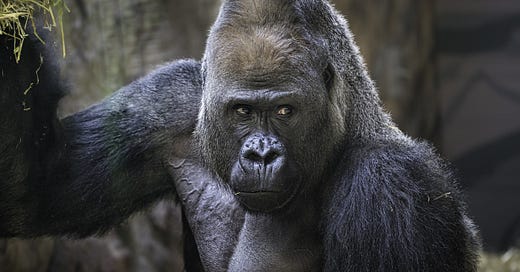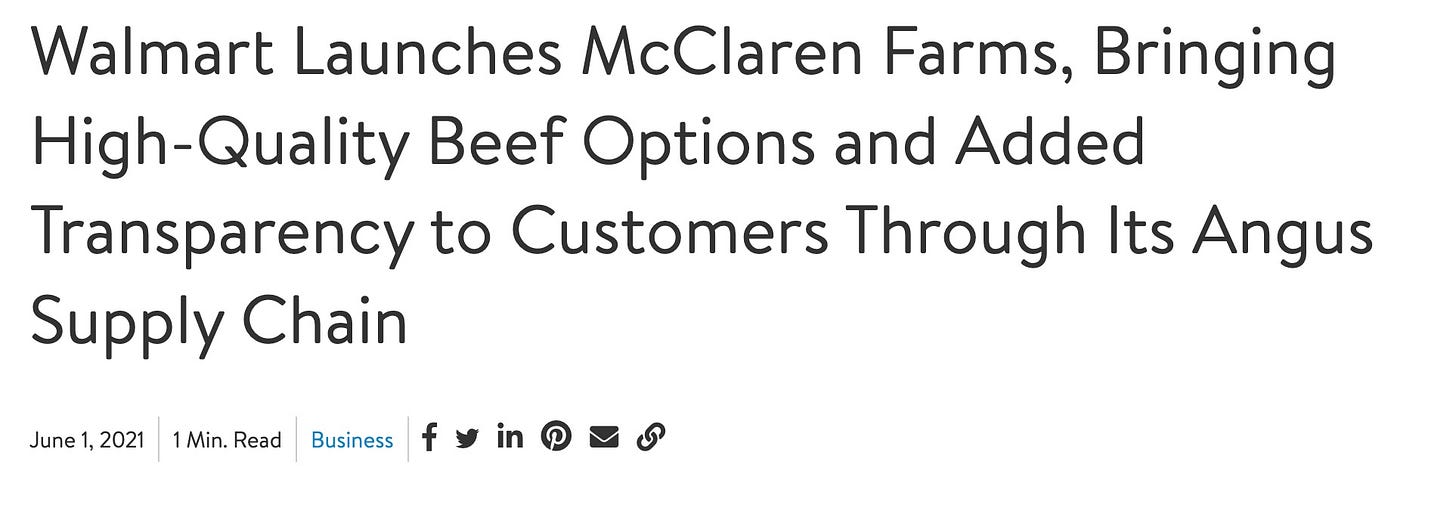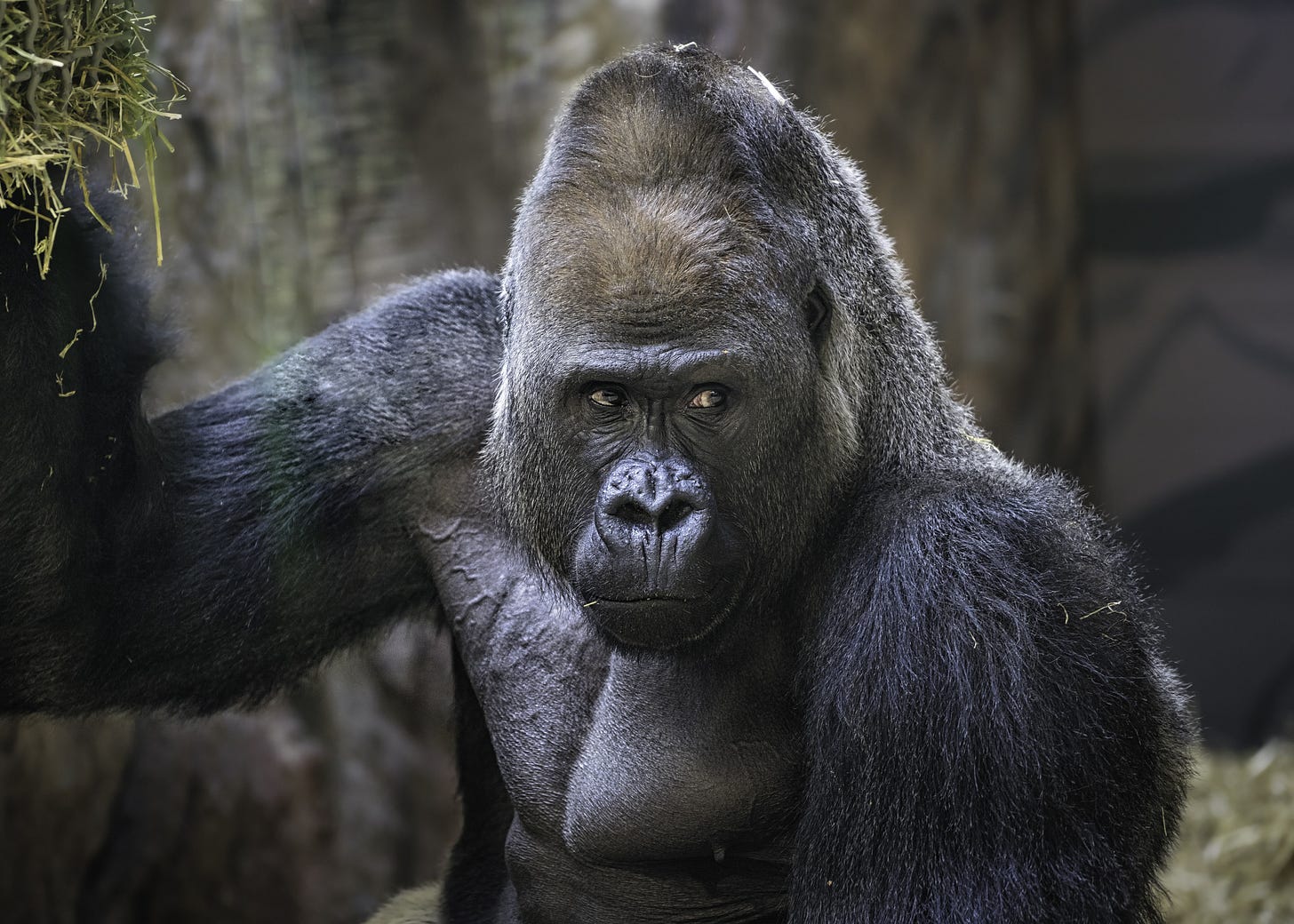Walmart: 800 pound gorillas make really weird dance partners
Prime Future 117: the newsletter for innovators in livestock, meat, and dairy
In 2019, the now $371.4 billion market cap retailer announced that they were tired of being treated like the red-headed stepchild by major beef packers and being the grocery store that shoppers went to for everything except beef. Walmart had decided to do something about it. It was time to level up:
In 2021, Walmart announced the launch of its premium fresh beef brand in 500 stores across the southeastern US, McClaren Farms:
In 2022, Walmart announced this:
A lot of folks say the minority investment in Sustainable Beef is a game changer.
I disagree.
It's interesting, but it’s nothing more than an incremental continuation of their current strategy. Not a shift, certainly not a game changer.
A Walmart minority investment in a slaughter plant makes sense given its recent investment in the supply chain behind its McClaren Farms brand, including the acquisition of a case-ready plant.
But if Walmart were serious about beef processing, they'd build/buy their own slaughter plant. Not make a minority investment in someone else's.
Today we look at why this minority investment is not a big deal, future potential moves Walmart might make that would be a big deal, and wargame how packers and other retailers might respond.
First, let's look at the scale of Walmart's retail beef business.
In the US, 2021 fresh beef sales at retail were $30.1 billion. And in 2021, Walmart had 18% of US grocery market share. Using rough math we can estimate Walmart beef sales at $5.1 billion. Given Walmart's efforts to improve the quality of fresh beef sold in their stores to increase per pound revenue AND volume, let's say they're targeting $8 billion in beef sales by 2025. Whether they hit that or not, this is not a tiny business.
But the bigger impact on the Walmart P&L might be from the 'basket lift', or the increase in the total spend, when a shopper buys beef. I don't have any idea whether that number is .25% or 25% or anywhere in between. But safe to say that when applied across Walmart's scale, it represents meaningful revenue.
Now contrast those beef numbers with the dairy case, specifically looking at fluid milk. Total 2021 US retail fluid milk sales were estimated at $12.6 billion so an estimated Walmart share is $2.3 billion.
Yet in 2016 Walmart announced it would be building its own milk processing plant in Indiana.
Milk is a much smaller business than fresh beef, yet Walmart opted for total control. That’s one reason my hypothesis is:
If Walmart were serious about beef, they would be buying or building their own kill plant.
Unless this minority investment is a precursor to a bigger move, the baby step before the monumental leap.
Let's assume Walmart has learned a lot in the last few years from their McClaren Farms aligned supply chain, working with 44 Farms to source Angus genetics and maintain alignment from cow-calf to feedyards to slaughter at Creekstone Farms to final processing at the Walmart case-ready plant operated by FPL Foods.
Contrast that with the supply chain for the remainder of their beef that is NOT McClaren Farms brand. That supply chain, from a Walmart perspective, is both simple and standard for a retailer: buy meat from the packer. Easy as pie.
With a few years of McClaren Farms learnings under their belt, let's assume the Walmart team has learned A LOT about aligning incentives, navigating industry fragmentation, the challenges of managing a complex biological system, managing costs through the supply chain, and more.
So it makes sense that the minority investment in a slaughter plant is another step in that journey both to scale and expand the McClaren Farms brand beyond the 500-store pilot, AND to continue learning in order to inform Walmart’s future strategy to continue elevating and differentiating its fresh beef offering.
Just for fun, let's play out some possible scenarios. What might Walmart's presence in the beef industry look like in 5-10 years?
Status Quo.Slowly grow the new McClaren Farms supply chain in & beyond the current 500 stores. Possible.Decelerate.Walmart exits Sustainable Beef, exits case-ready plant, winds down McClaren Farms brand. Possible but unlikely.Accelerate.Walmart decides that beef is as strategically central to its future in food retail as the rotisserie chicken is to Costco’s strategy, and echoes Costco’s decision to build a rotisserie chicken plant by buying/building a wholly owned Walmart beef slaughter plant. Highly likely, IMO.
Let’s say Walmart purchases or builds a beef slaughter plant in the next 3-5 years. How would Walmart's suppliers respond? What about retail competitors?
Let’s briefly wargame this from 3 angles:
What Sustainable Beef might do if Walmart bought/built a plant
What the big 4 packers might do (Cargill, JBS, Tyson, National Beef)
What other retailers might do (Kroger, Albertson’s, Amazon)
Let’s start with Sustainable Beef. Perhaps a Walmart acquisition is the likely exit strategy for early investors in Sustainable Beef. We recently talked about the criticality for these upstart plants of building a consistent customer base for carcass balance and revenue maximization, so let’s assume that Walmart is that anchor customer in the short run. So one scenario is that Walmart as anchor customer gets the plant to full utilization, and then if the business proves successful, Walmart buys out the other investors. That’s potentially a great outcome for those investors.
But also, there’s a risk that Walmart uses both the relationship with Sustainable Beef, and the insights gained from that relationship, as leverage with their other packer suppliers. Those other packer suppliers also happen to be the companies who, over the long term, are better positioned to be supplier partners to Walmart than Sustainable Beef because of their scale and diversity of capability.
The kicker is that if the McClaren Farms brand only sells into 500 stores today, that’s only a fraction of the total beef Walmart needs to source. The rest comes from the big 4.
So now that Walmart is a minority owner in Sustainable Beef, Walmart is both customer and quasi-competitor to the large processors.
This is messy stuff. You can’t ignore Walmart, it is definitely the 800 lb gorilla of beef retail customers. In this case, you have to dance with the 800 lb gorilla, but wow is it an awkward dance if you are both its competitor and supplier.
So what would the big packers do if Walmart went all in to buy or build a plant? I don’t have a good guess here. I’d love to hear from meat industry folks, because my best guess is that there wouldn’t be much response. It’s very impractical to think Walmart could process enough cattle to supply 100% of its beef supply, particularly when you take into account the cuts that Walmart sells in its meat case. So you would still have the packers as both customer & competitor, only in a more extreme scenario.
And what about other retailers? Would Kroger or Albertson’s follow suit? Would this be what drove Amazon into the packing business? I can see these players trying to replicate the aligned supply chain of McClaren Farms, or even buying their own case-ready plants. But I’m skeptical that it would make sense for any other retailer to make a move into slaughtering cattle given the necessary scale.
And then there are the known unknowns that could impact future Walmart decisions like how the macro environment might change from inflation to interest rates, how the cattle cycle moves, or how capital markets move. And whether in a few years the upstart plants breaking ground now are being sold as those operators realize the challenges of starting & running a beef processing plant (see Prime Future 114 below).
And then there are the unknown unknowns, the next black swan that either pushes Walmart further upstream or pulls them back to their safe space at retail.
That's a lot of unknowns. But the one thing we know for sure is that Walmart is the 800-pound gorilla of the retail meat case. And that gorilla won’t be ignored.
What a time to be alive 😉
ICYM Prime Future 114: Meatpacking isn’t rocket science (link)
It's weird how often people/media say that meat supply chains broke during COVID.
Were supply chains stress-tested? Absolutely.
Did supply chains bend? Yep.
Did supply chains break? I don't think so.
Consumers being forced to settle for a flank steak because the ribeyes are cleared out does not mean the supply chain broke, nor does being forced to settle for bone-in chicken thighs instead of boneless. These are objectively #firstworldprobz.
For those whose worldview says that supply chains broke, the go-to solution seems to be more localized, regional supply chains. To these folks, the cohort of soon-to-be-built processing plants looks like a golden next era of the meat business.
Then there are those who see packers as the source of all evil in the livestock value chain, those wretched keepers of the margin. To these folks also, the soon-to-be-built processing plants might also appear to mark the beginning of a golden era.
All that to say, there are a lot of folks cheering on the development of these new regional plants. As am I, if for no other reason than because competition makes everyone level up.
And yet, there's a phenomenon that has played out across the US beef industry for a few decades. Here's how it goes:
The cattle cycle swings margin to packers
Cattle producers think “hey, they can't have all the margin”
Cattle producers think “meatpacking isn't rocket science, we should buy/build a plant and capture some of that margin ourselves”
Cattle producers pool their money and buy/build a plant
The cattle cycle swings margin to cow-calf producers & feeders, away from packers
Cattle producer-investors declare bankruptcy on their processing business
Repeat at the next swing in the cattle cycle
With more recent announcements about plans for building regional packing plants, I’ve been thinking about some of the traps those plants will have to deftly navigate in order to avoid step 6 above.
Here are 4 watch outs for upstart meat processors:
(1) Sourcing cattle. With the drought in the US shrinking the cow herd by the day, the next 24-36 months could be a reeeally tough time to be establishing a processing business when competing with not only the big players but also a growing number of regional players for a smaller pool of cattle. Smaller supply + higher demand is great for producers but tough for processors…especially upstarts.
But cattle markets are local, and depend on the triangulation of (1) where these plants are located, (2) where the cattle they will source are located, all in relation to (3) where the big 4's plants are located. This location triangulation becomes all the more critical the higher transportation costs are, and the tighter cattle supply is.
(2) Competitive margins. These regional plants processing fewer head per day than their larger counterparts will have higher processing costs per pound, simply because of the math of spreading fixed costs across more pounds. And if you can't compete on cost, then you have to remain competitive via topline revenue which means either premium programs or some other path to higher sales price per pound. The big players largely play the commodity game with the mountain of meat; these emerging plants will have to create and play a different game.
(3) Carcass balance. Sourcing cattle and processing them efficiently are big enough challenges, but perhaps the biggest challenge of all is selling the entire carcass. Anybody can sell high-value middle meats, it takes a well-oiled sales machine to sell the entire carcass, even more so to do that at premium prices.
(4) Ability to recruit & retain talent, at all levels. Several hundred million dollars in capital projects for automation investments have been announced by the big 4 in the last few months, because of the labor crisis. Both accessing humans to do work, and the cost at which the humans are willing to work in a processing plant. This is not a small problem. This is not ‘build it and they will come’. A labor strategy right sized (read as: plan for higher wages than you would have even a year ago) for the current labor market is critical.
I wanted to test my hypothesis of the above traps with industry experts who’ve actually managed large-scale beef plants and know what it’s like to manage the business of buying cattle, processing and disassembling carcasses, and navigating customers relationships.
As someone who knows the beef processing business well, Nicole Johnson-Hoffman said, "I would agree with your watch outs and add that complexity is a factor. Unless you have a large organization to spread the costs across, you struggle to afford the high cost of compliance and sophisticated talent."
Meatpacking may not be rocket science, but it is wickedly complex.
Another industry friend added, "It's all about double shifting to be the most efficient. That’s a big battle and takes a lot of start-up capital for many years to turn the corner on profits. At first, you lose more the more cattle you kill as a total but you have to kill more cattle to ever get over the hump. It's a double edge sword.
Carcass utilization is the biggest link to packer profitability. You need international sales channels for items, plus retailers, plus food service. You need all 3 to balance the carcass. Plus hide, blood, rendering products that pay the bills. On top of that is the case-ready piece. If you're building a plant and not thinking about cutting the final product to a retail/food service customer then you can’t last playing the commodity game with the big 4. But you have to have a customer to do case ready."
There is a reason meatpacking has seen so much consolidation; it may not be rocket science but it is a deceptively challenging business.
Now for the bull case for these new plants:
If large cattle producers are invested in the plants, then that should increase the ability of the plant to secure cattle even when the big 4 are paying more for cattle than the regional plant can. The producer-investors will have a different level of economic commitment.
There are more opportunities than ever for branded programs and unique selling propositions that target a specific customer segment in a specific market.
Some argue the market has structurally changed in recent years with packer consolidation and that the cattle cycle is no longer the same. Maybe so. Maybe that structural change will mean these emerging packers will be operating in a different environment than prior attempts at this playbook with a higher probability of success.
I'm always going to be on the side of people making bold moves. I hope these moves pay off and that these producer-investors get Scrooge McDuck rich, start acquiring competitors, and keep growing until they themselves are considered big players who need shaking up by the next generation of upstarts. Circle of life.
Time will tell whether this time was different, whether this really is a new era in US meatpacking🤞







